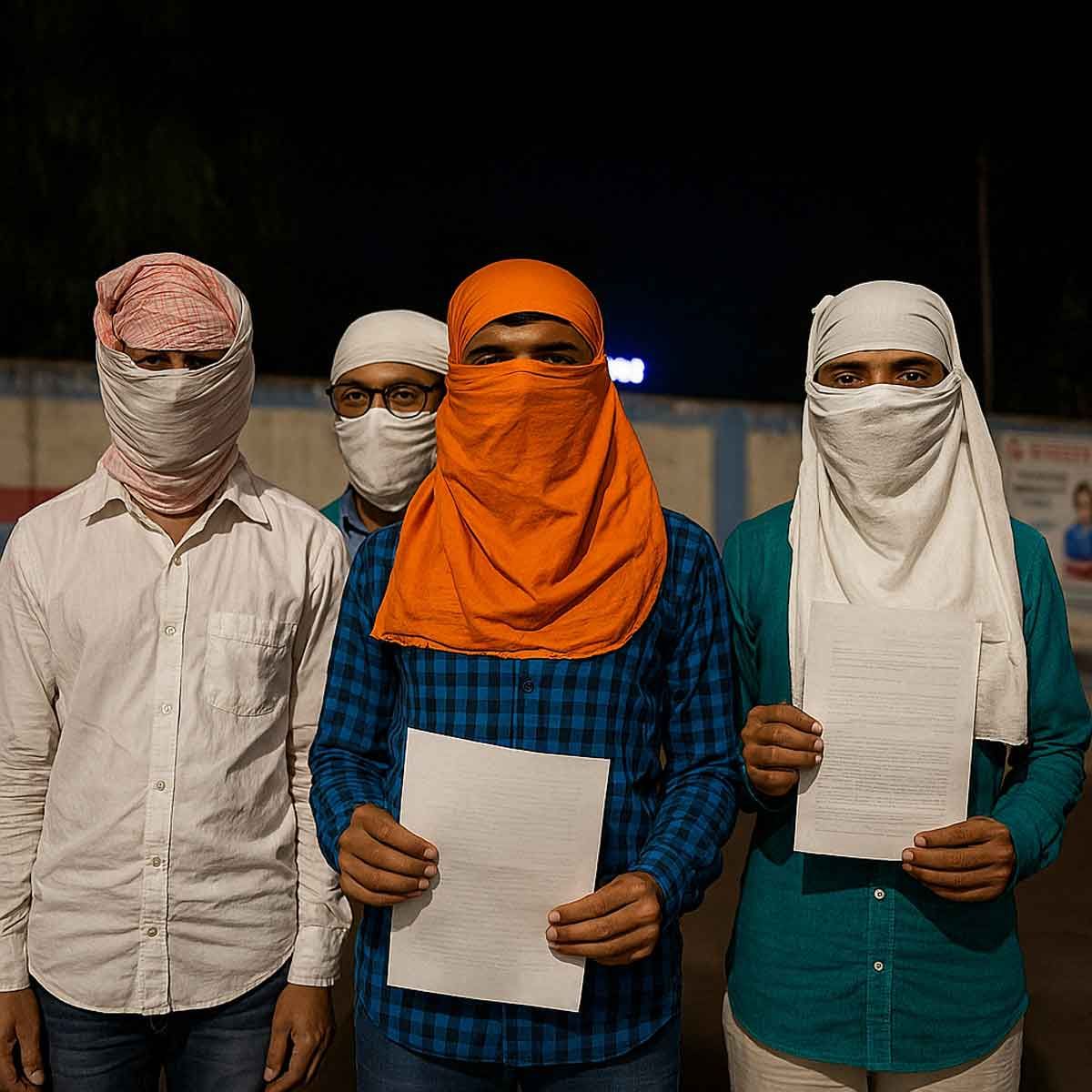More Coverage
Twitter Coverage
Satyaagrah
Written on
Satyaagrah
Written on
Satyaagrah
Written on
Satyaagrah
Written on
Satyaagrah
Written on
JOIN SATYAAGRAH SOCIAL MEDIA
"Everything depends on this: a fathomless sinking into a fathomless nothingness": Joshimath sinking - 10 crore people visit Uttarakhand a year, how much can it take say experts, Nainital, Mussoorie, Dharchula and several towns could face similar disaster

DEHRADUN: In 2022, close to five crore tourists, 3.8 crore Kanwar yatris and 45 lakh Char Dham pilgrims, visited Uttarakhand. While 2022 emerged as the most successful year for tourism in the context of footfall, it has simultaneously raised several questions about the infrastructure availability, carrying capacity of hill towns, scientific study, assessment and several other key factors related to the well-being of the mountains and residents.
|
Joshimath saw as many as 4.9 lakh visitors in 2019, 4.3 lakh visitors in 2018 and 2.4 lakh in 2017. On similar lines, Char Dham towns had 24 lakh devotees in 2017 and the number nearly doubled to 45 lakh in 2022.
People in Uttarakhand's Joshimath protest as houses develop cracks. The burden on two main hill stations, Mussoorie and Nainital, too, is on the rise. Barring the two seasons impacted by the Covid pandemic (2020 and 2021), there has been a significant increase in the number of tourists at these tourist spots.
In 2017, Mussoorie had 27 lakh visitors, 30 lakh each in 2018 and 2019, 10 lakh in 2020 and 12 lakh in 2021.
Joshimath - the sinking hill town of Uttarakhand
Residents of Joshimath Town in Chamoli district of Uttarakhand have been evacuating their homes and seeking safe refuge due to occurrences of land subsidence in the region. Huge cracks have appeared in the houses of the area due to this land subsidence which is known as the vertical sinking of land in an area. The winter season and the danger of house collapse due to landslides have now become a major issue in Joshimath Town. Nine wards of Joshimath town have been massively affected by landslides. The cracks in the walls and floors of the houses in the city area are getting deeper with each passing day
More than 3,000 people from 576 houses in the city area have been affected due to this subsidence. All the houses are being surveyed by the municipality. Many people have also left their homes. The people of Joshimath are worried about the future of the city.
A group of people from Joshimath is planning to visit Dehradun and meet with Uttarakhand chief minister Pushkar Singh Dhami to request assistance for those affected by subsidence. Chief minister Pushkar Singh Dhami has sought a detailed report from the district magistrate of Chamoli.
Terming it an "extremely serious matter", the CM has also instructed officials to provide the required relief to local residents. Traders "who were facing financial losses," to also be provided relief. All of us are now living on a ticking 'atom bomb' that can explode any moment, says a resident.
In the past 10 days, over 70 houses have developed cracks, says another resident. Cracks are also visible on the national highway, government school as well as hospital. Residents alleged that one of the major reasons behind the cracks was a 12km long tunnel of NTPC's Tapovan-Vishnugad 520 MW hydropower project.
NTPC officials had recently taken local mediapersons to show them the tunnel and claimed that it was all dry now, and the "sinking" is not due to their project. Joshimath is the last border town of strategic, religious, and tourist importance which falls into seismic zone V.
A team of experts has also conducted a survey of the town and found that it is gradually sinking with huge cracks appearing in a large number of houses. Similarly, 9.1 lakh tourists visited Nainital in 2017, 9.3 lakh each in 2018 and 2019, 2.1 lakh in 2020 and 3.3 lakh in 2020.
|
Demolish worst affected Joshimath homes, expert panel tells Centre, state
An eight-member expert panel has recommended that "houses in Joshimath with maximum damage should be demolished, areas which have become inhabitable must be identified and relocation of the people at risk should be done as an immediate measure".
The panel was led by Ranjit Sinha, secretary of the disaster management department. It conducted a field survey of Joshimath on January 5-6.
A senior official, privy to the report submitted both to the Centre and state government, told TOI on Saturday: “Prima facie, it appears that at least 25% area of Joshimath, which has a population of about 25,000, has been affected by the land-subsidence problem. A survey to ascertain the intensity of damage (to buildings and sundry structures) is currently underway. It will be put in three categories: severe, moderate and slight.”
Joshimath land subsidence: Experts start door-to-door survey
The expert team, which was urgently tasked to assess the damage to buildings and extent of ground subsidence (sinkage) in Joshimath, visited the affected areas during its two-day survey and finalised its report on Saturday, a copy of which is with TOI. It has observed "aggravated damages" in Sunil, Manohar Bagh, Singhdhar and Marwari areas, as compared to the last field survey just some months ago in August 2022.
The team also visited Jaypee Colony where an aquifer had burst on the night of January 2 with major turbid water flow of roughly 400 lpm (litre per minute). It has observed an "increased land-subsidence with the burst of the aquifer". The report said: “The gushing of water flow and the appearance of aggravated cracks coincide.”
It added: "The burst of water flow, which was traced from Jaypee Colony to Marwari, probably created some underground void space (sic), which has resulted in sinking and subsidence at different spots above and below Jaypee Colony, causing many large cracks -- some even a metre deep...Due to this, the retaining walls and foundations of buildings have failed, contributing to cracks in the buildings and on the ground... Yet, the water source is not ascertained. Samples have been collected to determine its source.”
Joshimath-Malari border road develops cracks due to land subsidence
The team went to the Tapovan-Vishnugad hydropower project site of NTPC as well. "Toe erosion" by the Alaknanda river was observed in Vishnuprayag and the team suggested building a "protection wall" at the toe of the left bank between Vishnuprayag and Marwari.
More detailed studies have been suggested, including fresh geo-technical, geophysical and hydrological investigations along with seismic and slope movement monitoring.
Meanwhile, the number of affected structures -- residential, commercial and even temples -- which have developed large cracks has increased from 561 to 603 within a span of a mere 48 hours. The holy town has been facing massive land-subsidence, aggravated significantly in the past few days.
A temple in Joshimath collapsed on Friday evening. No one was injured in the incident as the temple was abandoned. Fresh cracks have been reported in Shankaracharya Madhavashram temple too.
As of now, 55 families have been shifted out of their houses. District disaster management officer, Nand Kishore Joshi, said, “Identification of the affected areas and houses are in process and people living in vulnerable houses are being shifted to safer places.”
Chief minister Pushkar Singh Dhami had on Friday ordered immediate evacuation of around 600 families living in houses that have developed large cracks and are at risk.
|
Why is Joshimath sinking?
Located at a height of 6,000 feet in Uttarakhand's Chamoli district, Joshimath is a well known tourist town. Travellers heading to Badrinath, Hemkund Sahib, Auli and Valley of Flowers, among other religious and trekking destinations, halt here overnight, before travelling ahead. It is also of strategic importance to the Indian Army. To this end, in the past few decades, the hill town has seen an explosion of population and construction activities.
But what sets this town apart is its geography. It was built on an ancient landslide site, and has always had low bearing capacity. Hydroelectric projects and the expansion of the Rishikesh-Badrinath National Highway (NH-7) have made the slopes unsteady. Soil erosion due to running streams from Vishnuprayag and sliding along the natural streams have also had a role to play in sealing the town’s fate.
Why was nothing said so far?
Experts have warned for decades now that the area cannot handle the rampant construction that has been going on. The first such report came out in 1976. It indicated that an imbalance at Joshimath could threaten life and property.
The report – by the government-appointed Mishra Commission – was also the first to give out a crucial piece of information: that Joshimath was located on an ancient landslide, and thus built on an environmentally fragile area. It also falls in the high-risk seismic 'Zone-V', which meant it was more prone to earthquakes and ensuing landslides.
A 2006 report by Dr Swapnamita Vaideswaran, Scientist, Wadia Institute of Himalayan Geology, revealed that seepage from streams uphill had been observed, which may have loosened the soil of Joshimath. Local residents, on the other hand, add that nalas in the town have been blocked by sludge that came from the 2013 Himalayan tsunami.
|
Is there a larger environmental impact?
There has been a spurt in unusual weather events in the Uttarakhand Himalayas - increased frequency and magnitude of forest fires, avalanches, flash floods and landslides.
As the climate continues to warm, receding glaciers in the Uttarakhand Himalayas (there are around 900 in the region) have left behind enormous sediment in areas above 2,500 metres. They have the potential to cause catastrophic floods under unusual weather events.
The valleys here are also clogged with large quantities of loose sediments, making them fragile and unstable. It’s why the most destructive floods in the region have been triggered from these valleys.
Lastly, the whole region is vulnerable due to the presence of weak rocks and seismic activity. Landslides can obstruct rivers at any time and cause flash floods. like the 1978 Bhagirathi floods. Add no long-term environment conservation strategy and haphazard development to the mix, and you have a recipe for disaster.
Experts are recommending a complete shutdown of development and hydroelectric projects in the region, and replantation, especially at vulnerable sites to retain soil capacity. They are also asking that residents of Joshimath be shifted to safer locations immediately.
The Central government has already set up a panel to conduct a ‘rapid study’ of the occurrence of land subsidence and its impact in Joshimath. Also covered will be the effects of the sinking of land on human settlements, buildings, highways, infrastructure and riverine systems.
The sinking of Joshimath is a wake-up call on how human interference can have a deep impact on the ecologically fragile Himalayan region. It’s also why we can no longer continue to ignore the problem.
|
PM Modi assures Uttarakhand CM Dhami of full support on Joshimath crisis
Prime Minister Narendra Modi assured Uttarakhand Chief Minister Pushkar Singh Dhami of all possible help in the wake of land subsidence in Joshimath as result of which houses have developed cracks and over 60 families have been moved out.
“PM Modi had a telephone conversation with me asking about the situation in Joshimath and the steps taken for the rehabilitation and safety of people,” said Uttarakhand CM Dhami.
“The situation in Joshimath is being analysed. We’ll also see if other mountainous towns have achieved their toleration limit,” added Dhami.
“PM Modi assured all possible help to save Joshimath,” said the Uttarakhand CM.
Meanwhile, the Prime Minister’s office is holding a high-level meeting to take stock of the situation in Joshimath.
“Principal Secretary to the PM, P K Mishra, will hold a high-level review with the Cabinet Secretary and senior officials of Government and members of National Disaster Management Authority at PMO today afternoon,” an official press release said.
District Officials of Joshimath and senior officers of Uttarakhand will also attend the meeting through video conference on this issue.
The meeting is being held in wake of the cracks that have developed in the area in the last few days.
Uttarakhand CM Pushkar Singh Dhami has also directed to constitute a coordination committee at the government level led by the Additional Chief Secretary and at the local level under the chairmanship of Commissioner Garhwal, for the help and relief and rescue of the people affected by the Joshimath landslide.
The town of Joshimath also called Jyotirmath, is the winter seat of Lord Badrinath, whose idol is brought down from the main Badrinath temple to the Vasudeva temple in Joshimath every winter. The holy town of Joshimath is revered by the Hindus as an important pilgrimage centre of the country.
Following the appearance of cracks in the houses in Joshimath, a total of 66 families are reported to have migrated from Joshimath as of now.
“The district administration has made arrangements for the families affected by the natural calamity to stay in safe relief camps,” the administration said on Sunday.
References:
 Support Us
Support Us
Satyagraha was born from the heart of our land, with an undying aim to unveil the true essence of Bharat. It seeks to illuminate the hidden tales of our valiant freedom fighters and the rich chronicles that haven't yet sung their complete melody in the mainstream.
While platforms like NDTV and 'The Wire' effortlessly garner funds under the banner of safeguarding democracy, we at Satyagraha walk a different path. Our strength and resonance come from you. In this journey to weave a stronger Bharat, every little contribution amplifies our voice. Let's come together, contribute as you can, and champion the true spirit of our nation.
 |  |  |
| ICICI Bank of Satyaagrah | Razorpay Bank of Satyaagrah | PayPal Bank of Satyaagrah - For International Payments |
If all above doesn't work, then try the LINK below:
Please share the article on other platforms
DISCLAIMER: The author is solely responsible for the views expressed in this article. The author carries the responsibility for citing and/or licensing of images utilized within the text. The website also frequently uses non-commercial images for representational purposes only in line with the article. We are not responsible for the authenticity of such images. If some images have a copyright issue, we request the person/entity to contact us at This email address is being protected from spambots. You need JavaScript enabled to view it. and we will take the necessary actions to resolve the issue.
Related Articles
- 'Preserving state’s Cultural Heritage is important so Non-Hindus in Char Dham Yatra will have to undergo verification': Uttarakhand CM Pushkar Singh Dhami after concerns raised by Hindu religious seer
- "What matters is not the belief a man holds, but the depth at which he holds it": Historic Rani Sati temple is the largest temple in India dedicated to Rani Sati, a Rajasthani brave woman of Mahabharata times who committed Sati, also referred to as Dadiji
- For the first time in the history of Puri Srimandir, 40 to 100 earthen hearths in the kitchen of Shree Jagannath Temple of Puri in Odisha were vandalized inside the Rosa Ghara
- "Rioters were attacking after asking names, spared the Muslims": Journalist injured in the riots reveals, stone-pelted and clothes of female police officers were torn, Muslim peace committee meets Nainital DM after Rs 2.4 crore fine on accused Abdul Malik
- "Structure was a 700-year-old Machindranath temple": Thane's Haji Malang Dargah sees Maharashtra CM Eknath Shinde reassert a historic pledge for its liberation, amid long-standing disputes dating back to the 18th century regarding its Brahmin management
- In a momentous verdict, the Allahabad High Court directs Mathura administration to rectify the 2004 land misregistration, restoring the sacred grounds rightfully to Banke Bihari Ji Maharaj temple, unveiling a truth preserved from ancient times
- So-called atheist civilizing Hindu, a Periyarist cum Dravidian Stockist Youtuber denigrated Bhagwan Shiva and made obscene remarks about the cosmic dance of Nataraja claiming that it is the Sthal Puran of the temple
- “Kerala is superbly seen from a saddle, or with a paddle. No hour of life is wasted there”: Alleppey, also known as Alappuzha, a picturesque town of #Kerala famous for its backwaters and serene beauty has fascinated tourists for its floating houses
- “The bigmouths never visited Lord Ram’s birthplace and kept on playing politics”: Ram Mandir chief priest says only BJP cares about Ram Mandir, Modi did Shilanyas and CM Yogi visited 40 times
- RTI reply revealed that keys to the treasure room 'Ratna Bhandar' of Puri Jagannath temple which has a lot of gold, silver, and precious jewels donated by devotees and kings over the centuries have been ‘missing’ since 1970: Odisha
- Largest Hindu temple in the Southern Hemisphere opened in Johannesburg by Deputy President Paul Mashatile, with Mahant Swami Maharaj leading the consecration; built on a 14.5-acre site with 12,500 volunteers, serving as a hub for spirituality and unity
- “Sacred space is where you can find yourself over and over again”: Goa govt inked a MOU with Temple Connect to position Goa, popularly known as 'Bhagwan Parshuram Bhoomi', to be a global destination for spiritual tourism as 'Dakshin Kashi' of India
- PM Modi inaugurates rebuilt Shankaracharya samadhi in Kedarnath and said ‘Adi Shankara brought life to a sleeping civilisation, awakened Bharat to rise above caste boundaries’
- "Where snakes are family, fear sheds its skin": Maharashtra, in Shetpal village cobras roam freely amongst residents, a unique testament to India's deep-rooted harmony with nature, challenging perceptions and captivating visitors with its serpentine charm
- "Restoration & hope is available each time you turn to Sanatan": Besakih Mandir on slopes of Mount Agung in Eastern Bali is largest, holiest & important temple of Hinduism in Indonesia for history of its culture, archeology, architecture, social & economy




























